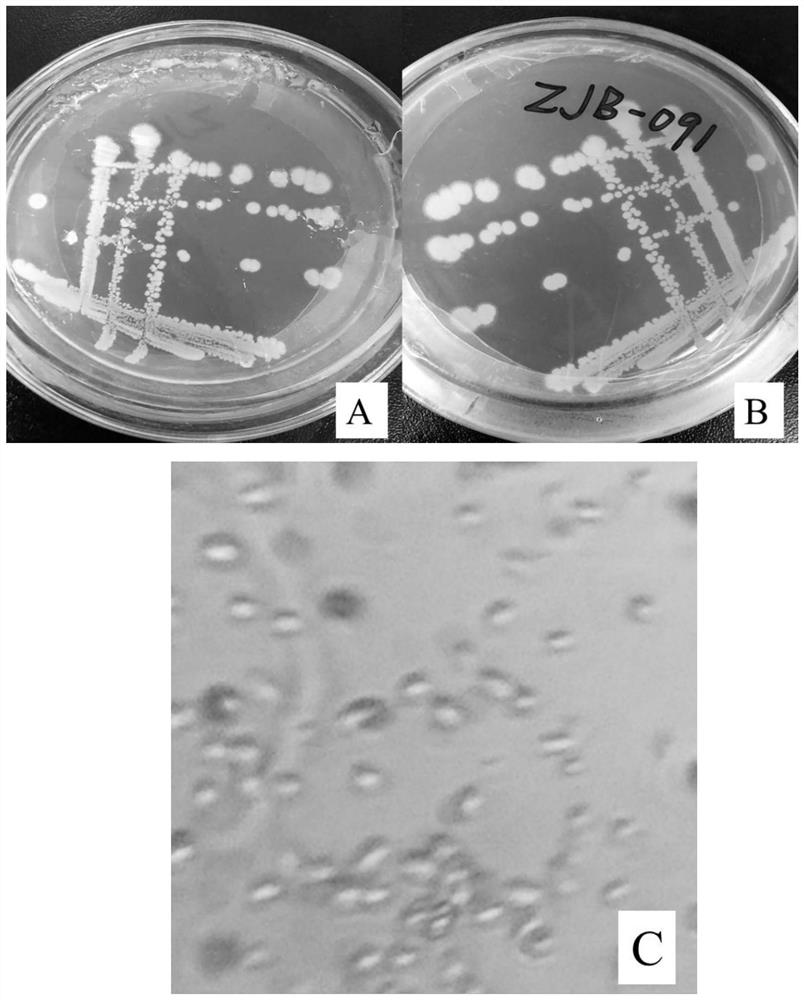Odorless microbial agent for kitchen waste treatment and its preparation method and application
A technology for microbial inoculants and kitchen waste, applied in the directions of microorganism-based methods, biochemical equipment and methods, microorganisms, etc., can solve the problem of inability to popularize and apply on a large scale, and achieve reduction in quantity, transportation, and application. good prospects
- Summary
- Abstract
- Description
- Claims
- Application Information
AI Technical Summary
Problems solved by technology
Method used
Image
Examples
Embodiment 1
[0049] Example 1 Screening and Identification of Predominant Bacteria for Degrading Food Waste
[0050] Take 5g of the soil sample near the Yuxiu Restaurant of Zhejiang University of Technology and put it into a sterilized Erlenmeyer flask with small glass beads and 50mL of sterile water, shake at 30°C and 200r / min for 20min, and suspend the bacteria in the ultra-clean bench. Liquid gradient dilution, the concentration gradient is 10 -1 、10 -2 、10 -3 、10 -4 、10 -5 、10 -6 、10 -7 , inoculate 100 μL of each concentration of bacterial suspension on a PDA plate, seal the plate with a sealing film and invert it, place it in a constant temperature incubator at 28-37°C for 24-48 hours, select a plate with a suitable number of colonies, and pick typical colonies , after separation and purification, inoculate them on protein, starch, fat, and cellulose differential medium plates and spread evenly with a sterilized coating rod. Seal the culture dish with a parafilm and place it ups...
Embodiment 2
[0074] Example 2 Determination of Enzyme Activity of Pichia kluyveri ZJB-091 and Geotrichumsilvicola ZJB-092
[0075] The isolated Pichia kluyveri ZJB-091 and Geotrichum silvicola ZJB-092 were inoculated into PDA liquid medium, shaken at 30°C for 48 hours, and the fermentation broth was kept at 4°C. Centrifuge at 8000r / min for 10min, and take the supernatant to measure the enzyme activities of amylase, protease, lipase and cellulase.
[0076]
[0077] Amylase activity is determined by DNS method. Definition of enzyme activity: the amount of enzyme needed to produce 1ug of maltose per minute in 1mL of enzyme solution, which is 1 unit of enzyme activity, expressed in "U / mL". The protease activity was determined by the Folin phenol method, and the definition of enzyme activity: the amount of enzyme needed to hydrolyze 1 mL of enzyme solution to produce 1 μg of tyrosine per minute, that is, 1 enzyme activity unit, expressed in "U / mL". The national standard GB / T 23535-2009 is u...
Embodiment 3
[0078] Embodiment 3 Food waste shaking bottle degradation test
[0079] Inoculate Pichia kluyveri ZJB-091 and Geotrichumsilvicola ZJB-092 on PDA slant respectively; culture them at 25-30°C for 24-48 hours to activate the strains; the activated PDA Slope components: 200g potato, 20g glucose, 20g agar, 1L water, natural pH, sterilized at 115°C for 30min.
[0080] Inoculate the activated Pichia kluyveri ZJB-091 and Geotrichumsilvicola ZJB-092 in potato dextrose liquid medium respectively; Shake culture for 48-72 hours to obtain Pichia kluyveri ZJB-091 bacterial liquid and Geotrichum silvicola ZJB-092 bacterial liquid. The medium used is potato glucose liquid medium: 200g potato, 20g glucose, 1L water, natural pH, sterilized at 115°C for 30min.
[0081]Pichia kluyveri ZJB-091 bacterial liquid and Geotrichumsilvicola ZJB-092 bacterial liquid were respectively inoculated into shake flasks containing food waste at a weight ratio of 10%, at 37°C Cultivate at 150-200r / min, and take ...
PUM
 Login to View More
Login to View More Abstract
Description
Claims
Application Information
 Login to View More
Login to View More - R&D
- Intellectual Property
- Life Sciences
- Materials
- Tech Scout
- Unparalleled Data Quality
- Higher Quality Content
- 60% Fewer Hallucinations
Browse by: Latest US Patents, China's latest patents, Technical Efficacy Thesaurus, Application Domain, Technology Topic, Popular Technical Reports.
© 2025 PatSnap. All rights reserved.Legal|Privacy policy|Modern Slavery Act Transparency Statement|Sitemap|About US| Contact US: help@patsnap.com



